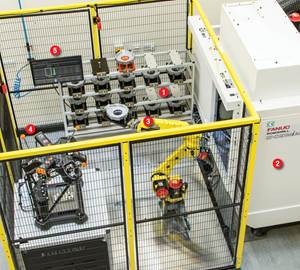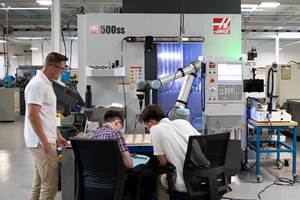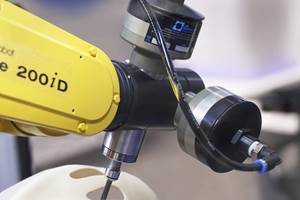3 Trends From PMTS 2025
The 2025 Precision Machining Technology Show provided an excellent look at the variety of machining solutions catering to the U.S. metalworking industry, including a range of automation solutions for turned and milled parts.
Share






The 2025 Precision Machining Technology Show took place April 1-3 this year, and from the beginning it was a whirl of activity. While it may be smaller than an event like IMTS, this show provides an opportunity for both larger and smaller OEMs to showcase their solutions, while conferences and workshops help attendees to think critically about the solutions they see on display. In the midst of all the networking, conferences and demonstrations, it is nearly impossible to see everything there is to offer. That in mind, here are three takeaways from my brief time in the whirlwind.
Automation Is King
Almost every machine tool on display at PMTS doubled as an automation display. Automation has simply become so vital to production for both high-production facilities and job shops that OEMs must consider it when designing machine tools.
The Robodrill Plus K Max package from Methods Machine Tools provides a flexible automation package in a compact footprint. It includes a full five-axis FANUC Robodrill with an integrated robot arm and loading area that users can customize to the needs of current jobs.
One interesting feature of automation at the show was the prevalence of integrated automation packages: machine tools sold with standard automation solutions as part of the package. Methods Machine Tools, for example, showcased the Robodrill Plus K Max package, which pairs a full five-axis FANUC VMC with a compact integrated robotic automation system. It comes standard with 90 pallet stations for small-to-medium sized parts loaded into the machine with a FANUC robot arm. It has a 90-slot tool magazine in addition to the 28-tool turret already in the machine tool’s work area. One uncommon feature of this package is that users can customize the tool and pallet stations, combining stations for larger workpieces or replacing tool stations with additional pallets. This customizability is designed to enable job shops to adjust the machining cell to the variety of jobs that come in.
The diamond-shaped dovetails on these parts have holes bored in the center of varying diameters. Each hole diameter corresponds to a tool path already loaded in the CNC, enabling the user to automate high-mix, low-volume part runs.
Haas provided a novel high-mix, low-volume automation solution in its booth, one the company’s team designed specifically for the show. A UMC 500 SS milling tool had a station of high-mix parts with various features but similar sizes, as well as diamond-shaped dovetails in the base of each workpiece. Both the robot arm and workholding were designed to clamp onto this self-centering dovetail with specialized grips. The robot would transfer a workpiece from the staging area to the workholding, and then the machine tool would use a probe to determine the diameter of the hole in the dovetail the robot had been gripping. Different machining tool paths were programmed to correspond to different hole diameters, and the machine would load up the corresponding program based on the probe’s measurement.
The MSR60 uses its integrated automation solution to make high-production machining available in a compact footprint.
Muratec showcased integrated automation in some of its turning solutions, such as the gantry-loaded MSR60 on display. The MSR60 is a single-spindle turning machine popular with job shops due to its gantry-loaded automation system, which provides the chance to automate both high-mix and low-mix part runs. According to the company, the gantry moves at 240 meters per minute thanks to its carbon fiber construction, which provides excellent durability at a low weight.
Tooling is the Slice of Life
Here we see an example of the Kendrill Micro at PMTS. This line of drills manages through-coolant channels at diameters as low as 0.5 millimeters and can go as deep as 50xD.
Perhaps unsurprisingly for a trade show with so many Swiss-type lathes on display, tooling designed for machining minute features into small parts filled the show. Kennametal, for example, showcased a number of micro-tooling solutions that use through-coolant to manage heat buildup. This included the Kendrill Micro line of drills that range from 0.5 millimeters to 2.9 millimeters, all of which sportthrough-coolant channels despite the tiny size. Guhring also showcased a line of micro mills with through-coolant channels. However, Guhring places the coolant holes further up the shank from the cutting edge to accommodate the complex geometry of the cutting tool. Both solution
Novelty Never Ends
One aspect of trade shows that remains consistent is the neverending supply of novel machining solutions. Derek Korn from our sister publication Production Machining covered the Nano, a desktop Swiss-type lathe that uses fully functional guide bushings. Maintaining the rigidity needed for Swiss-type turning at that size is an accomplishment in and of itself, but this machine does so in a compact space that runs on only 120 volts of power.
I spoke at length with representatives from , a machine tool manufacturer that supplies compact machine tools to both grade schools and trade schools to grow the pool of workers for the industry. The EDU Mini Mill can fit on a workbench at less than 3 feet wide. Working off of a FANUC control, the mill can machine metal parts and help students learn the ins and outs of machining at an early age.
Every booth had an interesting perspective and interesting technology. Moreover, the sense of community fostered by the Precision Machined Products Association running the show provides genuine excitement in both the exhibitors and attenddees, which makes attending the show a joy year after year.
Related Content
3 Ways Artificial Intelligence Will Revolutionize Machine Shops
AI will become a tool to increase productivity in the same way that robotics has.
Read More5 Stages of a Closed-Loop CNC Machining Cell
Controlling variability in a closed-loop manufacturing process requires inspection data collected before, during and immediately after machining — and a means to act on that data in real time. Here’s one system that accomplishes this.
Read MoreCNC Machine Shop Honored for Automation, Machine Monitoring
From cobots to machine monitoring, this Top Shop honoree shows that machining technology is about more than the machine tool.
Read MoreHow to Accelerate Robotic Deburring & Automated Material Removal
Pairing automation with air-driven motors that push cutting tool speeds up to 65,000 RPM with no duty cycle can dramatically improve throughput and improve finishing.
Read MoreRead Next
AMRs Are Moving Into Manufacturing: Considerations for Implementation
AMRs can provide a flexible, easy-to-use automation platform so long as manufacturers choose a suitable task and prepare their facilities.
Read MoreMachine Shop MBA
Making Chips and 91ÊÓƵÍøÕ¾ÎÛ are teaming up for a new podcast series called Machine Shop MBA—designed to help manufacturers measure their success against the industry’s best. Through the lens of the Top Shops benchmarking program, the series explores the KPIs that set high-performing shops apart, from machine utilization and first-pass yield to employee engagement and revenue per employee.
Read MoreLast Chance! 2025 Top Shops Benchmarking Survey Still Open Through April 30
Don’t miss out! 91ÊÓƵÍøÕ¾ÎÛ's Top Shops Benchmarking Survey is still open — but not for long. This is your last chance to a receive free, customized benchmarking report that includes actionable feedback across several shopfloor and business metrics.
Read More





















